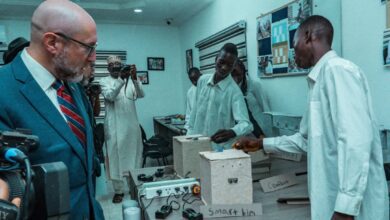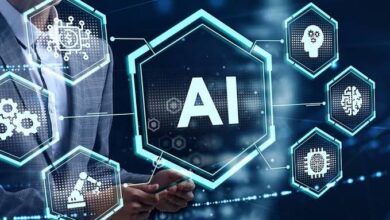Dr. Olaosebikan Canvasses Use Of AI In Risk Communication, Strategies

Dr. Omolaraeni Olaosebikan, the CEO of McEnies Global Communications has identified Artificial Intelligence’s (AI) predictive capabilities to be invaluable for risk communication, adding that it has the potential to put forward flawless strategies that can aid disaster prevention and management.
According to this integrated marketing expert, machine learning algorithms now have the foolproof ability to predict potential risks based on historical data and past occurrences. She maintained that this feat allows organizations to proactively address risks before they escalate and communicate with relevant stakeholders in a more informed manner and in the nick of time.
Dr. Omolaraeni dropped these hints during an interactive session with brand and tech reporters on Thursday, February 1, 2024, at her Lagos Office in Magodo GRA off CMD Road.
Recall that Omolaraeni last year won a contract with The Meteorological Office UK (Met Office) to develop improved communications practices on flood crisis information and work out meaningful risk communication strategies to mitigate perennial flooding in Nigeria.
The project is being sponsored by the UK Foreign Commonwealth and Development Office (FCDO) and it is expected to bring together several relevant government agencies, like NIMET, NASRDA, NIHSA, NEMA, etc while also engaging in some desk-based research and consultations.
She said: “Artificial Intelligence (AI) has revolutionized risk communication by enabling organizations to analyze data, predict risks, and communicate with stakeholders more effectively with precision to solutions.
“In recent times, I have been involved in flood management, and natural disaster studies with the MET Office and FCDO which you are aware of and I desire I go steps further to be more involved in ways to help the vulnerable people amongst us. Those who day-to-day live in abject poverty and deprivation because of what natural disasters, pandemics, and other related crises have done to them and the government possibly not even looking to help their needs and preferences.”
The very engaging session took a better part of the female CEO’s time on Thursday even as she professionally responded to how to mitigate social vulnerability through AI-assisted risk communication strategies.
Her words, “Risk communication essentially relies heavily on data analysis to identify potential threats, trends, and patterns. As I’ve said previously, AI-powered tools can process vast amounts of structured and unstructured data from various sources, including social media, news articles, and reports, to uncover valuable insights. By analyzing this data, organizations can gain a better understanding of emerging risks and tailor their communication strategies accordingly.
“AI’s predictive capabilities are invaluable for risk communication. Machine learning algorithms can predict potential risks based on historical data and past occurrences. This foresight allows organizations to proactively address risks before they escalate and communicate with stakeholders in a more informed manner.”
Fielding questions on empowering vulnerable communities with risk communication and AI technology strategies for resilience and safety, the McEnies Global Communications CEO reacted and said:
“AI can seamlessly help to mitigate the risks identified by providing recommendations, actions, and solutions. It can equally use data-driven awareness to suggest the best ways to reduce or eliminate the risk and create safety nets for the target or vulnerable segments of society. The aggregates of insights drawn from this can ultimately help to either enforce policies through government agencies or legislation from the Parliament, or run advocacy programmes to deepen the right message and techniques for the target groups and relevant stakeholders especially during, before, or after emergency situations.”
While stressing on risk communication and AI technology strategies and dose for saving social vulnerability, Omolaraeni gave this submission to the media:
“I’m not here to stir any scare, but the reality is that the fourth industrial revolution is in full swing, bringing with it a wave of technological advancements that have the potential to reshape every aspect of human life across the globe. Artificial Intelligence is at the forefront of this revolution, promising to transform various sectors and drive inclusive growth. In Africa, could the adoption of AI and related technologies accelerate the continent’s development and help to achieve the United Nations Sustainable Development Goals (SDGs)? The answer is Yes!”
“Natural disasters are inherently unpredictable, but their consequences can be mitigated through early intervention and effective preparedness. These events can have devastating economic, social, and environmental impacts. Preventing natural disasters or minimizing their damage is a global imperative. AI, with its ability to process vast amounts of data, analyze patterns, and make real-time predictions, will definitely revolutionize our approach to disaster prevention.
“Before delving into the ways AI can assist in disaster prevention, it’s crucial to understand the nature of these events. Natural disasters are broadly categorized into geological, meteorological, hydrological, and climatological phenomena. Earthquakes, volcanic eruptions, and tsunamis fall under geological disasters, while meteorological disasters include hurricanes, tornadoes, and blizzards. Hydrological disasters involve floods and landslides, and climatological disasters encompass droughts, heatwaves, and wildfires.
“One of the most crucial aspects of disaster prevention is providing early warnings to vulnerable populations. AI-powered systems can process data from various sources, including weather sensors, satellites, and social media, to detect early signs of impending disasters. For example, in the case of hurricanes, AI algorithms can analyze atmospheric data to predict their path and intensity accurately. These predictions enable authorities to issue timely warnings and evacuate individuals at risk-prone areas and saving countless lives”
In the aspect of enhancing social vulnerability with AI Technology and risk communication, she noted; “Data-driven artificial intelligence technologies are progressively transforming the humanitarian field, the use of digital technologies in humanitarian action again should not be seen as a new phenomenon. Yet, contemporary advances in computational power, coupled with the availability of vast amounts of data, have allowed for more widespread use of digital technologies in the humanitarian context.
“The COVID-19 pandemic has further accelerated the trend of using digital technologies to help maintain humanitarian operations. AI is broadly understood as a collection of technologies that combine data, algorithms, and computing power. These technologies based on my understanding consist of software and possibly also hardware systems designed by humans that, given a complex goal, act in the physical or digital dimension by perceiving their environment through data acquisition, interpreting the collected structured or unstructured data, reasoning on the knowledge, or processing the information, derived from this data and deciding the best action to take to achieve the given goal and mitigate against disaster.”
On the need to bridge the gap and explore the intersection of AI technology and risk communication, she said;
“Globally, modern workplaces are undergoing a profound digital transformation, and of course here in Nigeria, we shouldn’t be caught napping. In line with this global shift. We must start to recognize and utilize the unparalleled value of AI’s capabilities. These capabilities bring enhanced operational procedures, heightened productivity upscale success stories, and a growing range of innovative service offerings. As AI systems become increasingly integrated, we must learn to follow the trend, reshaping the foundation of communication in risk and disaster management, know how to predict right, and cater to diverse needs and preferences. This transformation weakens the traditional ties within incumbent financial institutions and paves the way for entirely new operational models.
“AI is reshaping the landscape of risk communication, empowering organizations to analyze data, engage with stakeholders, and respond to crises more effectively. By harnessing the potential of AI and upholding ethical standards, organizations can enhance their risk communication strategies and build stronger relationships with stakeholders in today’s rapidly changing world. As technology continues to evolve, AI’s role in risk communication will only become more significant, making it an indispensable tool for modern risk managers and communication professionals. And for us at McEnies Global Communications we’re moving at the speed of light to meet up with contemporary standards in tandem with global best practices”, she stated.






